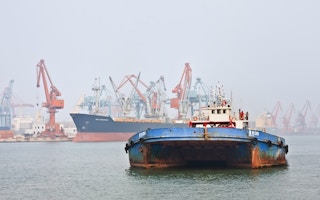Rescue teams and environmental experts struggled amid rain on Tuesday to clean up thousands of tons of water polluted by last week’s massive explosions in the northern Chinese city of Tianjin, while the city mourned the 114 people known to have died in the disaster.
Tens of thousands of tons of contaminated water is believed to remain at the warehouse and container area that were ripped apart by fires and two huge explosions, while the current downpour could make decontamination still harder, official media reported.
Water tested at eight of the 40 water monitoring stations near the blast area were found to contain excessive amounts of cyanide, with some samples containing 28.4 times more than the standard, Tianjin’s chief environmental protection engineer Bao Jingling was quoted as saying.
Officials have estimated that hundreds of tons of toxic sodium cyanide were stored near the blast site, and construction teams are using a cofferdam to prevent contaminated rainwater from running off the site, state news agency Xinhua reported.
There are also fears that rain might set off chemical reactions with the scattered chemicals and release toxic gases, Bao said.
A Tianjin resident surnamed Zhao told RFA she was afraid to go outside, for fear of pollution.
“Just think what could happen when the rain hits those dangerous chemicals; a lot of them are all over the ground,” Zhao said. “I have shut tight the windows and I don’t open the door much.”
“If there is poison in the air, a face mask is no use; I saw that on social media,” she said. “If you breathe it in, you can get a chronic disease.”
“We’re not going out now, and anyone who gets rained on comes back and takes a shower as soon as they can; that’s all we are thinking about right now,” Zhao said.
Unaware of risk
According to official figures, 114 people died in the disaster, while 57 remain missing after two huge explosions ripped through the Tanggu district of the port just before midnight on Aug. 12.
Memorial ceremonies marking the seventh day since the deaths of the 114 people were attended by officials in Tianjin, while the city was decked out in white mourning flowers and echoed with sirens on Tuesday.
Meanwhile, local residents are still in shock at the scale of the potential hazards to their lives and health.
“Nobody thought that they would put dangerous chemicals so close to a residential area,” a resident of Tanggu told RFA on Tuesday.
“I’m pretty worried now,” he said.
A resident surnamed Wang said he had no idea how hazardous the warehouse area could be.
“I didn’t realize how very dangerous this was until this happened,” Wang said. “There was a bomb right next to me.”
He said the blast had shaken up people who might otherwise have been apathetic about the risk.
“We want to be able to supervise what the government is doing … and we want to live in an environment that is guaranteed safe. But it’s not we who decides these things,” Wang said.
“We have no power to pursue them, and if we start to criticize the government, or blow the whistle on them, then they will treat us like the enemy,” he said.
“All we can do is accept orders from on high.”
Clampdown on reporting
The ruling Chinese Communist Party has clamped down on reporting of the disaster, ordering state-run media to stick to officially approved news stories, deleting tweets, and shuttering social media accounts deemed to be “spreading rumors” about the Tianjin explosions.
According to David Bandurski, researcher at the Hong Kong University’s China Media Project, some 35 million people were watching the Twitter-like hashtag #Tianjinexplosion on Sina Weibo as the tragedy unfolded and citizens posted dramatic and often graphic images of the devastation on the ground.
“The primary objective of China’s leadership can be summed up in a single phrase: ‘Do not do reports of a reflective nature,’” Bandurski wrote in an article on Medium.com.
While many Chinese reporters have risked life and limb to get closer to the story, any reporting that addresses who is responsible, why the disaster occurred, and how safety measures failed is off limits, Bandurski said.
A Tanggu resident surnamed Chen said that people were completely unaware they were living so close to such dangerous chemicals.
“What exactly went on with these explosions? Why were such dangerous goods held there?” Chen said.
“We had to run for our lives, and we escaped, but we were nearly finished,” he said. “Our apartment complex and our building has collapsed.”
“But for every question asked, they just say three ‘don’t knows’. It doesn’t matter who you ask.”
“This was the government’s job, and it didn’t do its job. They are just passing the buck, acting irresponsibly. How could this happen?”
Warehouse executives held
Currently, the official narrative appears to be focusing on the bosses at warehouse owner Ruihai Logistics and local municipal officials as mainly to blame for the disaster.
Police are holding 10 Ruihai executives, including the CEO, while the head of the national work safety watchdog Yang Dongliang has been put under internal party investigation for “severe discipline violations.”
Relatives of the missing said they still haven’t had any detailed news of their loved ones’ fate.
“They just said they’ll inform us as soon as they have news,” the sister of missing man Liu Tianlong told RFA.
“We asked for a meeting but they didn’t do that.”
Copyright © 1998-2014, RFA. Used with the permission of Radio Free Asia, 2025 M St. NW, Suite 300, Washington DC 20036.










